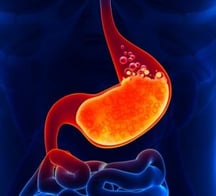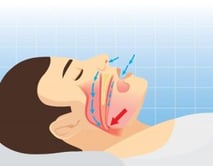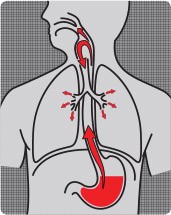The Connection Between Gastric Reflux, Obstructive Sleep Apnea, & Diet
AAOSH’s stated purpose is “Connecting Medicine and Dentistry to Save Lives.” Gastric reflux, obstructive sleep apnea, and diet illustrate both oral and whole body connections that have life-altering implications.
 Gastric Reflux involves the backflow of stomach acids, bile, and digestive enzymes upward through the open esophageal sphincter, the esophagus (Gastroesophageal Reflux/Gastroesophageal Reflux Disease/GERD), and the airway—including the lungs, mouth, nasal passages and sinuses (Laryngopharyngeal Reflux/LPR/Airway Reflux).
Gastric Reflux involves the backflow of stomach acids, bile, and digestive enzymes upward through the open esophageal sphincter, the esophagus (Gastroesophageal Reflux/Gastroesophageal Reflux Disease/GERD), and the airway—including the lungs, mouth, nasal passages and sinuses (Laryngopharyngeal Reflux/LPR/Airway Reflux).
There are several common risk factors for gastric reflux including hiatal hernia, overeating, eating too late at night, obesity, smoking, stress, obstructive sleep apnea (OSA) and an unhealthy diet.
Let’s discuss the latter two in more detail.
Gastric Reflux and OSA
 OSA creates a negative pressure in the pharynx as strong respiratory effort is made with no air exchange. Diaphragmatic contraction and opening of the esophageal sphincter result in pulling acidic stomach fluids up the esophagus and into the airway. When chronic pooling occurs, a high pepsin, low pH/acidic inflammatory condition can lead to Barrett’s Esophagus, asthma-like symptoms, and potentially influence esophageal cancer.
OSA creates a negative pressure in the pharynx as strong respiratory effort is made with no air exchange. Diaphragmatic contraction and opening of the esophageal sphincter result in pulling acidic stomach fluids up the esophagus and into the airway. When chronic pooling occurs, a high pepsin, low pH/acidic inflammatory condition can lead to Barrett’s Esophagus, asthma-like symptoms, and potentially influence esophageal cancer.
While OSA may be associated with an increased incidence in gastric reflux it is also apparent that gastric reflux can produce esophageal and airway inflammation, spasms of the vocal cords, compromise the airway and possibly stimulate OSA. These two disorders often occur in tandem, leading to a chicken and egg question of which causes the other.
Gastric Reflux and Diet
 Dropping Acid, The Reflux Diet Cookbook & Cure describes the research of Jamie Koufman M.D., exposing the damaging effects of pepsin digestive enzymes in gastric reflux. Pepsin powerfully breaks down proteins in the stomach and is activated by stomach acids when food is swallowed. With gastric reflux, pepsin backflows into the esophagus and airway, nasal passages and lungs.
Dropping Acid, The Reflux Diet Cookbook & Cure describes the research of Jamie Koufman M.D., exposing the damaging effects of pepsin digestive enzymes in gastric reflux. Pepsin powerfully breaks down proteins in the stomach and is activated by stomach acids when food is swallowed. With gastric reflux, pepsin backflows into the esophagus and airway, nasal passages and lungs.
The typical western diet is very acidic. Sports drinks, sodas, canned foods, citrus, caffeine and all sources with a pH< 4 can activate pepsin molecules attached to the walls lining the esophagus and airway. Pepsin will damage the surrounding tissue causing irritation, inflammation and swelling. Acid suppressant medications are often insufficient. Effective treatment requires a change of diet, eliminating acidic foods, drinks and fried foods, with no eating after 8:00 p.m.
Clinical Application
50,000 patients completed an online survey, conducted by Dr. Koufman, asking, “Think you might have reflux? Which symptoms do you have?”
These common responses followed:
- 15% post-nasal drip
- 14% chronic throat clearing & “lump in the throat” sensation
- 11% sore throat
- 10% chronic cough & heartburn (most commonly associated with reflux)
- 7% choking episodes
Gastric reflux screening should cover the common symptoms. Patients with “Silent Reflux” report none of the above symptoms. If signs are present, such as tooth biocorrosion, consider a referral to an experienced otolaryngologist or gastroenterologist.
When signs and symptoms of gastric reflux are present, include two important considerations:
- Screen & test for the presence of OSA.
- Screen & counsel an alkaline diet with appropriate lifestyle improvements.
- Provide copies of books such as Dropping Acid (2012) and Dr. Koufman’s Acid Reflux Diet (2015).
It is essential to dig deeper into our patients’ health histories and symptoms in order to fully understand the full extent of the problem. Making the important connections between lifestyle factors, clinical presentation, and seemingly unrelated symptoms is what we in the AAOSH community do best—and our persistent focus on treating the whole patient will continue to improve and save our patients’ lives.
